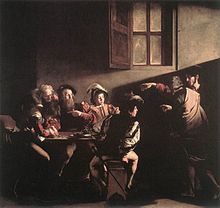chiaroscuro

Chiaroscuro ( Italian : "light-dark"), light-dark painting , also French. : Clair-obscur , describes a design medium of graphics and painting developed in the late Renaissance and Baroque periods , which was characterized by strong light-dark contrasts and served both to increase spatiality and expression .
term

Light Dark the Eindeutschung the artistic style term chiaroscuro ; What is meant by this are the ways of painting and seeing in painting, especially in the Baroque period , as can be seen, for example, in Caravaggio or Rembrandt van Rijn and their successors. In contrast to Leonardo's gentle sfumato , the painters of the 16th and 17th centuries were primarily concerned with the dramatic expression that could be achieved in oil painting through subjects that were brought into light against a dark background.
Uses and Effects
The artist uses the effects of light and shadow to model bodies and forms more clearly and to emphasize their spatiality, to increase dramatic effects or to create an expressive mood. The nuances in the gradation of the brightness values range from heightened areas to highlights and shadows .

painting
One of the first artists to deal intensively with the relationship between light source and illuminated object and the conditions of light and shadow was Leonardo da Vinci . He distinguished between luce (luminous light) for the illuminating and lumen (body light) for the light emanating from the illuminated, as well as natural and artificial light. Using the effects of chiaroscuro, Leonardo emphasized the uncovered body and face, while he used a smoky-misty veil of soft light for the transparent atmosphere and, through this sfumato, achieved shades of the background up to the dissolution of the contours.
A particularly dramatic form - called Tenebrismo - was developed by Caravaggio shortly before 1600, who used hard, directional light to lift the figures out of their surroundings and to express their inner tensions. Rembrandt van Rijn used chiaroscuro effects in many of his graphics and paintings, especially to depict mental sensitivities. Georges de la Tour , Peter Paul Rubens , Francisco de Zurbarán and Diego Velázquez were also masters of this technique.
Graphics and drawing
Chiaroscuro drawings are those on colored paper having a dark color, and white highlights that the objects plastically can appear. In woodcuts , Clair-obscur is the term used to describe the method of creating shadow effects and thus plasticity by printing different dark areas from different wood blocks.
The clair obscur woodcut (light-dark cut) is a variant of the woodcut technique that achieves a painterly effect, as aimed at in the drawing . The aim of the process is to create a chiaroscuro effect, which can be achieved using a brush or pen drawing technique on a colored background. Such drawings are characterized by the fact that parts of the shadow are inked and lights are put on using opaque white, for example in so-called heightened drawings.
The print is done using two to three differently cut sticks . The first reproduces the black line drawing, the second a (lightness) tone value . The third printing block can add a darker variant of the tone that is between that of the first and second printing blocks. The light effect is created by cutting out the corresponding illuminated areas on all printing blocks . The white of the paper color can then be seen at these points.
The Dutch wood cutter Jost de Negker is considered to be the inventor of this method, which he used for the first time in 1507.
Film and photography
The term chiaroscuro effect is also used to describe similar effects in film and photography. The “chiaroscuro effect” is of great importance for film noir and is a characteristic feature of this style. This effect is used as a creative means for individual shots in low-key photography with side light and deep shadows and is achieved through targeted underexposure.
Important representatives

Chiaroscuro (painting)
- Leonardo da Vinci (1452-1519)
- Antonio da Correggio (1489–1534)
- Titian (around 1490–1576)
- Caravaggio (1571-1610)
- Simon Vouet (1590-1649)
- Georges de la Tour (1593-1652)
- Trophime Bigot (1597-1650)
- Rembrandt (1606-1669)
- Jan Vermeer van Delft (1632–1675)
- Monies (student of Rembrandt) (1645–1727)
- Joseph Wright of Derby (1734-1797)
- Artemisia Gentileschi (1593–1654)
Clair-obscur (woodcut)
- Albrecht Altdorfer
- Ugo da Carpi
- Andrea Andreani
- Andrea Mantegna
- Lucas Cranach the Elder Ä.
- Hans Baldung Grien
literature
- Light and shadow. In: Lexicon of Art. Volume III. Berlin 1981, p. 7ff.
- Marcus Stiglegger : Film noir. In: Thomas Koebner (Hrsg.): Sachlexikon des Films. Stuttgart 2007, p. 224ff.
Individual evidence
- ↑ Ernst Strauss: Color history studies on painting since Giotto. Munich 1972.
- ^ Reference material for libraries 8, 1/4, 2000.
